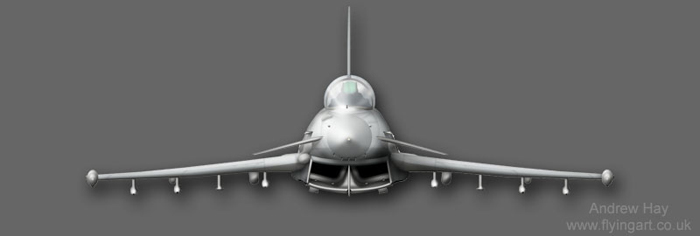
The Eurofighter Typhoon is a twin engined, swing role, canard delta strike fighter aircraft; designed and built by a consortium of European aerospace manufacturers through Eurofighter GmbH.
The series production of the Eurofighter Typhoon is now underway and the aircraft has formally entered service with the Royal Air Force, German Air Force, Italian Air Force and the Spanish Air Force.
The history of the Typhoon is a long complex one, mainly due to funding delays and political procrastination, and not through any fault of the design. The types history dates back an amazing thirty five years to 1972 when the RAF issued Air Staff Target 396 (AST-396), a requirement for a new Short Take-Off Vertical Landing (STOVL) fighter to replace the Harrier, Jaguar and Phantom in the ground attack role. The requirement was refined later the same year under AST-403 for an STOVL air superiority fighter, however this STOVL requirement was later removed and added to AST-409, which in turn led to the development of the MkII Harrier GR.5; later evolving into the current GR.7 and GR.9.
The AST-403 remained and along with a similar West German requirement was to form the basis of what would eventually become the Eurofighter Typhoon.
In 1979 British Aerospace and Messerschmitt-Bölkow-Blohm presented a formal proposal to their respective governments for the ECF, the European Collaborative Fighter or European Combat Fighter.
Later joined by Dassault joined the ECF team for a tri-national study, which became known as the European Combat Aircraft, it was at this stage of development that the Eurofighter name was first linked to the aircraft.
The costly development of different national prototypes continued; France with its ACX, the UK with the P.110 & P.106 and West Germany with its TFK-90.
Following Dassault’s insistence on "design leadership" and emerging differing national requirements, the ECA project collapsed in 1981. As a result the Panavia partners (BAe, MBB and Aeritalia) launched the Agile Combat Aircraft (ACA) programme in April 1982. The influences of the period were quite evident on the proposed design; the Soviet Air Force was close to introducing the Su-27 and MiG-29 into front line service, albeit as part of what was to develop into the final stages of the Cold War. The ACA was very similar to the BAe P.110, having a cranked delta wing, canards and a twin tail. One major external difference was the replacement of the side mounted engine intakes with a chin intake. The ACA was to be powered by a modified version of the Tornado’s RB199 engine.
Following political arguments, project funding was withdrawn by the German and Italian governments, however the UK Ministry of Defence agreed to pay £80 million to fund the project and pay for the construction of a demonstrator aircraft with additional funding later provided by MBB and Aeritalia.
ZF534, the ACA demonstrator was manufactured at Warton and rolled out on 27th October 1985. After extensive ground testing its first flight took place on 8th August 1986, going supersonic in the hands of Chief Test Pilot Dave Eagles.
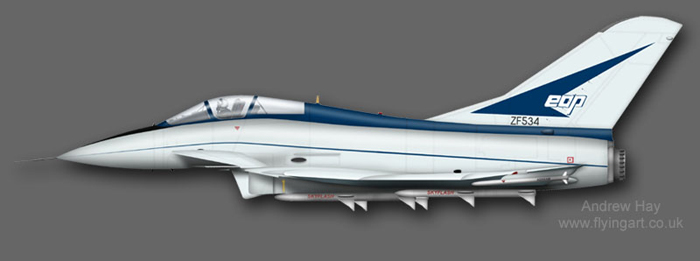
The aircraft contributed a wealth of flight data during a five year test period which ended on 1st May 1991. A total flying time of 195 hours 21 minutes was logged during 259 sorties. ZF534 now resides with Loughborough University in Leicstershire for use as a training aid within the Department of Aeronautical and Automotive Engineering and used in undergraduate design appreciation studies.
In 1983 the UK, France, Germany, Italy and Spain launched the Future European Fighter Aircraft (FEFA) programme. The aircraft was to have Short Take Off and Landing (STOL) and Beyond Visual Range (BVR) capabilities. In 1984 France reiterated its requirement for a carrier-capable version and demanded a leading role. The UK, Germany and Italy opted out and established a new EFA programme.
In Turin during August 1985 Italy, West Germany and the UK agreed to go ahead with the Eurofighter. The announcement of this agreement confirmed that France, along with Spain, had chosen not to proceed as a member of the project. However despite pressure from France, Spain rejoined the Eurofighter project in early September 1985. The French officially withdrew from the project to pursue its own ACX project, the Dassault Rafale.
1986 saw the establishment of the Munich based Eurofighter Jagdflugzeug GmbH to manage development of the project and EuroJet Turbo GmbH, the alliance of Rolls-Royce, MTU Aero Engines, FiatAvio (now Avio) and ITP for development of the EJ200.
By 1990 the selection of the aircraft's radar had become a major stumbling block. Britain, Italy and Spain supported the Ferranti Defence Systems-led ECR-90, while Germany preferred the APG-65 based MSD2000 (a collaboration between Hughes, AEG and GEC-Marconi). An agreement was reached after UK Defence Secretary Tom King assured his West German counterpart Gerhard Stoltenberg that the British government would underwrite the project and allow GEC to acquire Ferranti Defence Systems from its troubled parent. GEC thus withdrew its support for the MSD2000.
In late 1990 it became apparent that the German government was not happy about continuing with the project. The Luftwaffe was tasked to find alternative solutions including looking at cheaper variants of Eurofighter. The German concerns over Eurofighter came to a head in July 1992 when they announced their decision to leave the project. However, on insistence of the German government some time earlier, all partners had signed commitments to the project and they found themselves unable to leave at this stage.
The maiden flight of the Eurofighter EF2000 prototype finally took place on 27th March 1994. MBB chief test pilot Peter Weger took the prototype on a test flight around Bavaria.
In 1995 political concerns over workshare appeared. Since the formation of Eurofighter the workshare split had been agreed at United Kingdom 33%, Germany 33%, Italy 21% and Spain 13%, figures based on the number of units being ordered by each contributing nation.
The next major milestone came at the Farnborough Airshow in September 1996 when the UK announced the funding for the construction phase of the project.
In November 1996 Spain confirmed its order but Germany again delayed its decision. After much diplomatic activity between Britain and Germany, an interim funding arrangement of DM 100 million (€51 million) was contributed by the German government in July 1997 to continue flight trials. Further negotiation finally resulted in German approval to purchase the Eurofighter in October 1997.
However, all the nations then reduced their orders. Britain cut its orders from 250 to 232, Germany from 250 to 140, Italy from 165 to 121 and Spain from 100 to 87. According to these order levels the workshare split should have been 39%, 24%, 22% and 15% respectively. Germany however, was unwilling to give up such a large amount of work. In January 1996 after much negotiation between UK and German partners, a compromise was reached whereby Germany would take another 40 aircraft from 2012 and a new workshare of 30%, the eventual splits becoming 37%, 30%, 20% and 13% respectively.
Thus, when the final production contract was signed in 1997, the revised procurement totals were as follows: UK 232, Germany 180, Italy 121, and Spain 87. Production was again allotted according to procurement: British Aerospace (37%), DASA (30%), Aeritalia (20%), and CASA (13%).
The Eurofighter Typhoon is unique in modern combat aircraft in that there are four separate assembly lines. Each partner company assembles its own national aircraft, but builds the same parts of all 620 aircraft.
- Alenia – Left wing, outboard flaperons, rear fuselage sections
- BAE Systems – Front fuselage (including canards), canopy, dorsal spine, tail fin, inboard flaperons, rear fuselage sections
- EADS
- German division– Main centre fuselage
- Spanish division– Right wing and leading edge slats
Production is divided into three "tranches" (see table below) with an incremental enhancement to capability with each tranche. The capability enhancement provided by the tranche 2 contract includes full air-to-ground capability, as well as significant enhancements to the flight control software and the Defensive Aids systems. Tranches are further divided up into batches and blocks, eg the RAF's tranche one twin seaters are batch 1 T.1s and batch 2 T.1As.
Production Summary
Country |
Tranche 1 |
Tranche 2 |
Tranche 3 |
Total |
Austria |
0 |
15 |
0 |
15 |
Germany |
44 |
68 |
68 |
180 |
Italy |
29 |
46 |
46 |
121 |
Saudi Arabia |
0 |
48 |
24 |
72 |
Spain |
20 |
33 |
34 |
87 |
United Kingdom |
55 |
89 |
88 |
229 |
TOTAL |
148 |
299 |
260 |
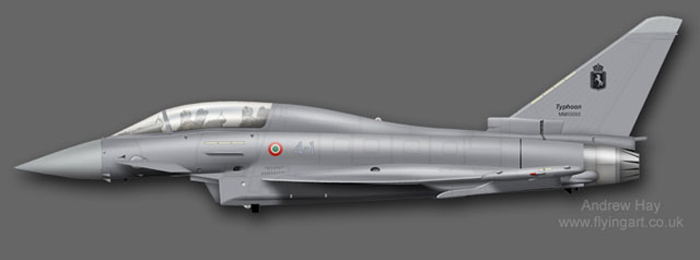
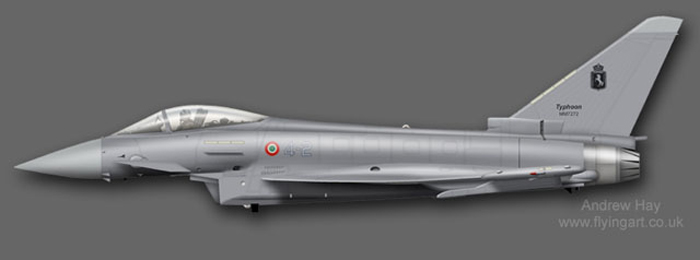
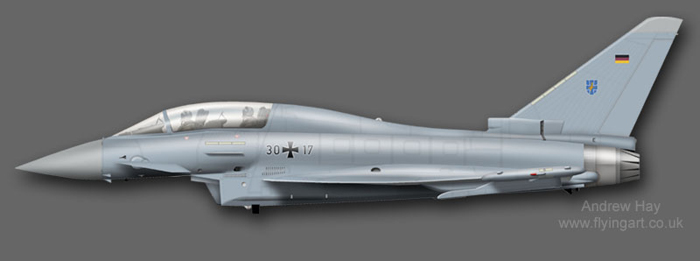

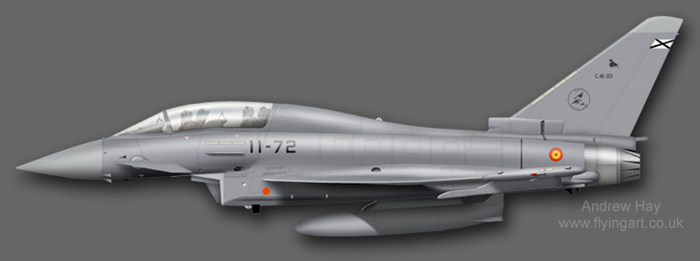
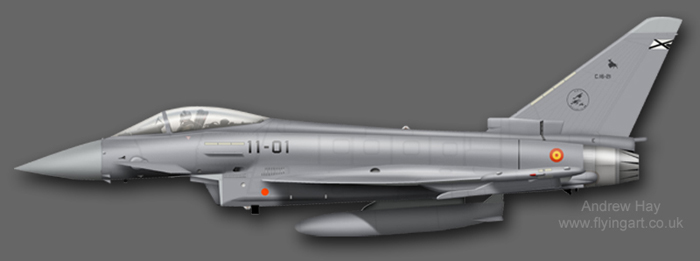
RAF service:
The RAF’s Typhoons were introduced into service via an (at the time) unique programme christened "Case White"; an eighteen month programme that saw BAe responsible for the introduction of the Typhoon into RAF service. 1040 sorties were contracted to be flown to include pilot conversion and operational test and evaluation.
The establishment of the first two Typhoon squadrons at Warton, 17(R) & 29(R), allowed BAe to assume more responsibility for training and support of the new aircraft than previous RAF types which were introduced into service under a more “in house” system. The system resulted in the inevitable teething problems associated with any aircraft to be quickly ironed out by BAe personnel on site.
17(R) Sqn re-located from Warton to Coningsby on 1st April 2005, followed by 29(R) on 1st July 2005.
In RAF service it is planned that the Typhoon front-line will comprise seven Sqns, of which four will be primarily air defence, two swing-role and one offensive support. Following the completion of "Case White" in mid 2005 all subsequent deliveries are made to RAF Coningsby, the home of 3(F), XI(F), 17(R) and 29(R) Sqns.
The sole remaining Jaguar Squadron, 6, relinquished the type in October 2007 and is expected to re-form with the Typhoon at Coningsby during 2009, followed by re-location to RAF Leuchars. The other Typhoon Sqns to operate alongside 6 Sqn are at the time of writing unknown, although open to speculation.
Following November 2007's release-to-service for RAF Block 5 Typhoons to carry LGB's, it was announced that all Typhoons built or upgraded to the PIRATE sensor equipped multi-role Block 5 configuration (or higher) would be re-designated from Typhoon T.1 to T.3 (for the two seat version) and from F.2 to FGR.4 (for the single seat version). The revised designation denotes the Fighter, Ground Attack and Reconnaissance roles.
Typhoon abroad:
On 2nd July 2002, the Austrian government announced the Typhoon would be its next air defence aircraft, replacing leased Swiss F-5E Tiger IIs. The purchase of eighteen Typhoons was finalised on 1st July 1 2003 with four due for delivery to Zeltweg during 2007, twelve in 2008 and two in 2009. These aircraft are being assembled at the EADS facility in Manching, Germany.
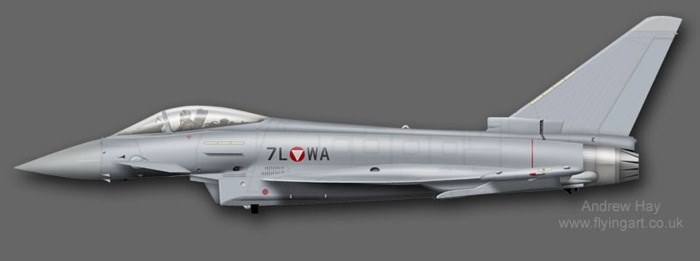
After unsuccessful sales campaigns in South Korea and Singapore, on 18th August 2006 BAe announced that Saudi Arabia would purchase 72 Typhoons at an estimated cost of £10 billion. An initial 24 aircraft are to be supplied from the RAF’s tranche 2 order, with first deliveries to a UK based OCU (Operational Covernsion Unit) expected during early 2008.
Typhoon Facts:
With a unit price approaching £65 million the Typhoon introduces a new level of agility, performance, stealth features and advanced avionics into RAF service. Compared to its rivals, the Typhoon is one of the most capable operational fighter aircraft with a cockpit and man/machine interface claimed to be significantly advanced and intuitive, resulting in a lower pilot workload. The conventional HOTAS (Hands On Throttle And Stick) concept was enhanced with a direct voice input system to allow the pilot to perform mode selection and data entry procedures. The Typhoon's combat performance, particularly compared to the new F-22A Raptor and the F-35 currently under development in the United States and the French Dassault Rafale, has been the subject of much speculation. Whilst beyond the scope of this article, there is a study by the UK's DERA comparing the Typhoon to other contemporary fighters. In it, the Typhoon was second only to the F-22A in combat performance.
In March 2005, United States Air Force Chief of Staff General John P. Jumper, then the only person to have flown both the Typhoon and the Raptor, talked to Air Force Print News about these two aircraft. He said that "the Eurofighter is both agile and sophisticated, but is still difficult to compare to the F-22 Raptor. They are different kinds of airplanes to start with; it's like asking us to compare a NASCAR car with a Formula 1 car. They are both exciting in different ways, but they are designed for different levels of performance".
In June 2005, Scotland on Sunday reported that, when 'attacked' by two USAF F-15E Strike Eagles, a Typhoon on a 'Case White' conversion training sortie from BAe’s Warton facility was able to out manoeuvre the attacking aircraft and subsequently achieve radar lock for a long enough period of time to simulate a missile launch against them. The Strike Eagle is primarily a ground attack aircraft ableit with swing role capability. It is, however, generally agreed that the Typhoon's performance is significantly better than that of the F-15C/D, the current air superiority fighter variant of the F-15.
While the Typhoon lacks the all-aspect stealth technology of the F-22A, the design does incorporate some low-observable features. Its actual detectability on radar is classified. Passive infrared target detection and tracking (air-to-air and air-to-surface) is provided by PIRATE (Passive Infra-Red Airborne Track Equipment), serving also as a navigation and landing aid.
The Typhoon is capable of sustained supersonic cruise without using afterburners, also known as "Supercruise". The F-22A is the only other current fighter with this capability. According to EADS, the maximum speed possible without reheat is Mach 1.5 in what EF GmbH regard as a 'clean' configuration — e.g., without tanks, but with four BVRAAMs and two IR AAMs. (Supercruise performance drops to Mach 1.3 with a full air-to-air weapons load, including tanks).
The Rafale's supercruise capabilities have been described as marginal with the current engine, whilst the F-22 by comparison can supercruise slightly faster with a full internal weapons load.
Canards, lightweight construction (around 70% carbon fibre composites) and the inherently unstable design with a quadruplex digital control system providing artificial stability, allow superior agility both at supersonic speed and at very low speed. The fly-by-wire system is described as "carefree" by preventing the pilot from exceeding the permitted manoeuvre envelope.
BLOCK 5 and PIRATE
The Typhoon force is expected to remain in service for over 25 years; clearly there is still much to be written on the aircraft, however June 2007 saw the F.2s of 3(F) Sqn take over the southern QRA duty, albeit initially on a 'month on, month off' basis with Leeming’s XXV(F) Sqn until their disbandment in March 2008. The summer of 2008 is widely expected to see the first operational deployment overseas, when XI(F) Sqn heads east to Afghanistan. The Typhoon is expected to replace the Tornado F.3s of 1435 Flight, however this is subject to operational requirements elsewhere and no time frame has been set for the types first deployment to the South Atlantic.
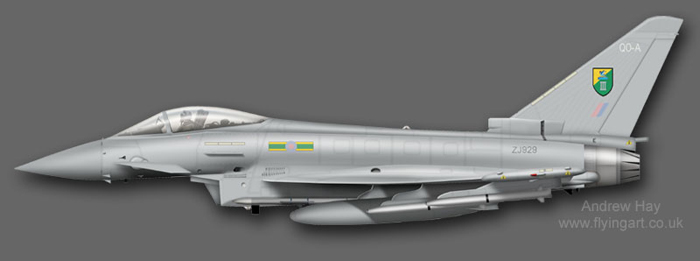
Longer term there is the expectation of additional export sales and the possible development of a dedicated IDS two seat Typhoon equipped with conformal fuel tanks and a new Storm Shadow variant to suit the RAF’s Future Offensive Air System (FOAS) programme, a replacement for the Tornado GR.4 strike aircraft from 2018.
The Block 5 capabilities can be described as full air-to-air and initial air-to-ground capability with full carefree handling. The aircraft is cleared for the 9g envelope as intended, with additional features such as sensor fusion, the full Direct Voice Input, enhanced GPS, the DASS (Defensive Aids Sub-System) countermeasures including automatic Chaff and Flare dispensers, radar air-to-surface modes including ground mapping, and initial FLIR (Forward Looking Infra-Red).
In terms of weapons, the Block 5 Typhoon will be equipped with AMRAAM, ASRAAM, IRIS-T and the proven AIM-9L air-to-air missiles, plus Laser Guided Bombs (LGB) such as the Paveway II and GBU-16.
The Block 5 aircraft are the final build standard from Tranche 1. The R2 programme is being carried out by the four Partner Air Forces and will be the standard to which 115 earlier Eurofighter Typhoons are brought up to. This will also be the capability standard of the 15 aircraft on order to the Austrian Air Force.
The PIRATE (Passive Infra Red Airborne Tracking Equipment) is a 2nd generation Imaging Infra Red (IIR) system using passive detection.
PIRATE incorporates both a Forward Looking Infra Red (FLIR) and Infra Red Search and Track (IRST) capability. The system utilises a highly sensitive Infra Red sensor mounted to the port side of the canopy, allowing the detection of both the hot exhaust plumes of jet engines as well as surface heating caused by friction. By super cooling the sensor even small variations in temperature can be detected at long range. Although no definitive ranges have been released an upper limit of 80 nautical miles (nm) has been hinted at but a more typical figure would be 30 to 50nm. The use of processing techniques further enhances the output, giving a near high resolution image of targets. The actual output from the system can be directed to any of the Multi-function Head Down Displays mounted within the cockpit. Additionally the image can be overlaid on both the Helmet Mounted Sight and Head Up Display.
The IIR sensor is stabilised within its mount so that it can maintain a target within its field of view. Up to 200 targets can be simultaneously tracked by the system using one of several different modes; Multiple Target Track (MTT), Single Target Track (STT), Single Target Track Ident (STTI), Sector Acquisition and Slaved Acquisition. In MTT mode the system will scan a designated volume space looking for potential targets. In STT mode PIRATE will provide high precision tracking of a single designated target. An addition to this mode, STT Ident, allows for visual identification of the target. Once a target has been tracked and identified PIRATE can be used to cue an appropriately equipped short range missile such as ASRAAM.
Passive Air-to-Air target detection and tracking performance in the IRST mode provides totally covert-tracking capabilities. PIRATE also fully supports Air-to-Surface operations in the FLIR mode, with ground and target imagery as required during missions where passive operations are also needed.
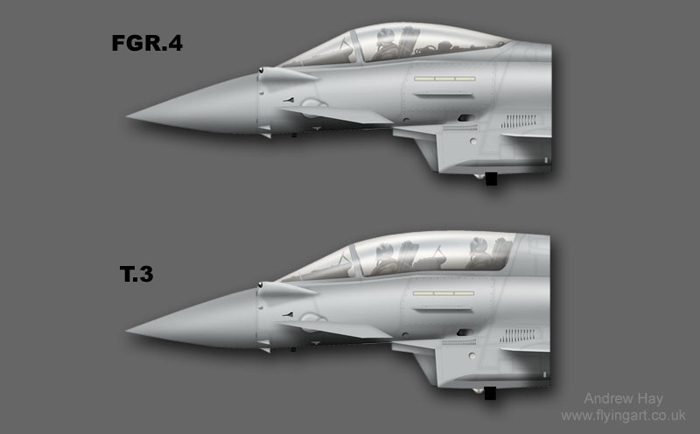
Development Aircraft (DAs):
DA1 98+29: The first Eurofighter. Built in Germany with its first flight taking place March 1994, the aircraft is a single seat variant and used for ongoing airframe and flight control system (FCS) development. 500 flights in this role had been performed by September 2004.
DA2 ZH588: The first UK single-seat Typhoon; first flight from Warton was during April 1994. DA2 was the only member of the DA family to be fitted with an anti-spin gantry and spin recovery systems. DA2 is also primarily involved in edge of envelope slow speed clearance, as well as FCS development. Delivered to RAF Coningsby on the 29th January 2007 for use as ground weapons trainer prior to display at the RAF Museum at Hendon.
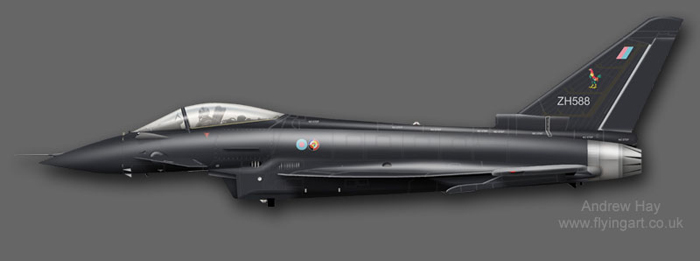
DA3 MMX602: An Italian single-seat aircraft, DA3 made its first flight from Caelle, Italy, in June 1995. Used for development and testing in a wide variety of activities, including armament development. DA3 is currently the only single-seat aircraft to carry the BK-27 Mauser cannon and is used for firing clearances and development.
DA4 ZH590: DA4 was retired from flying duties on the 13th December 2006 following nearly ten years of extensive UK based avionics testing. Delivered to RAF Coningsby for future use as a ground instructional airframe, DA4 was the first of the type to be fitted with radar and had been the leader in the development of the avionics suite, including attack systems, for Tranche 1, and was at the forefront of Tranche 2 avionics testing.
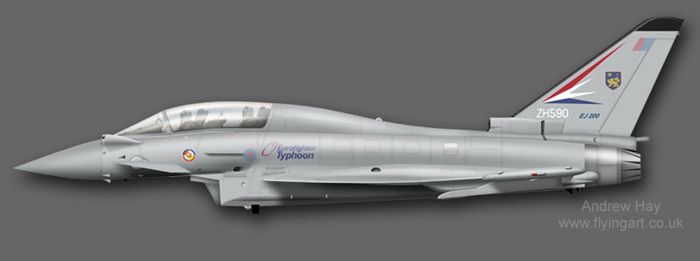
DA5 98+30: A German single-seat aircraft, first flight was from Manching in February 1997. DA5 is fitted with radar and complimented DA4 in the development of the avionics suite. DA5 is currently being upgraded to Tranche 2 development standard and will assist with Tranche 2 testing.
DA6 XCE.16-01: A Spanish twin-seat aircraft, first flight was from Seville in August 1996. DA6 assisted in airframe development, handling qualities and flutter testing but was sadly lost during a test flight in November 2002.
DA7 MMX603: The second Italian single seat Typhoon, DA7 made its first flight from Caselle in January 1997. DA7 is fitted with radar and performs navigation and avionics testing. Additionally, this aircraft carries out missile clearance development and is involved in the majority of the first firing exercises.
Instrumented Production Airframes (IPAs):
Five Instrumented Production Airframes (IPA) have been delivered to further expand the development programme. The IPA fleet consists of three twin seat and two single seat aircraft. The twin seat aircraft will test and prove the production capabilities of both system and production software standards while the single seaters are designated with the task of securing clearances for the single seat production standard aircraft.
IPA1 ZJ699: BAe Instrumented Production Standard Twin Seat. First flight 15th April 2002 from Warton, UK.
IPA2:Alenia Instrumented Production Standard Twin Seat. First flight 15th April 2002 from Caselle, Italy.
IPA3:EADS Instrumented Production Standard Twin Seat. First flight 11th April 2002 from Manching, Germany.
IPA4 C.16-04: EADS Instrumented Production Standard Single Seat. First flight 27th February 2004 from Getafe, Spain.
IPA5 ZJ700: Instrumented Production Standard Single Seat. First flight 7th June 2004 from Warton, UK.
Series Production Aircraft (SPAs):
The introduction of the Series Production Aircraft (SPA) is the end result of all the efforts of the DA and IPA fleets and test pilots. This, along with the achievement of customer type acceptance, is a major milestone towards the development of tranche 2 and in reaching the final operating capability.
GT001 98+31 (expected to be re-numbered as 30+01 following service acceptance): Production Standard Twin Seat. The first of 180 Eurofighter Typhoon aircraft planned for the German Air Force. First flight from Manching 13th February 2003.
IT001 MM7235: Production Standard Twin Seat. The first of 121 aircraft planned for the Italian Air Force. First flight from Caselle 14th February 2003.
BT001 ZJ800: Production Standard Twin Seat. The first of 232 aircraft planned for the Royal Air Force. First flight from Warton 14th February 2003.
ST001 CE.16-01: Production Standard Twin Seat. The first of 87 aircraft planned for the Spanish Air Force. First flight from Getafe 17th February 2003.
In November 2006 BAE Systems commenced an upgrade programme to bring forty three tranche 1 RAF Typhoons up to a common standard. Scheduled maintenance will take place at the same time as the upgrades, aircraft are returned to Warton from Coningsby for the work to take place.
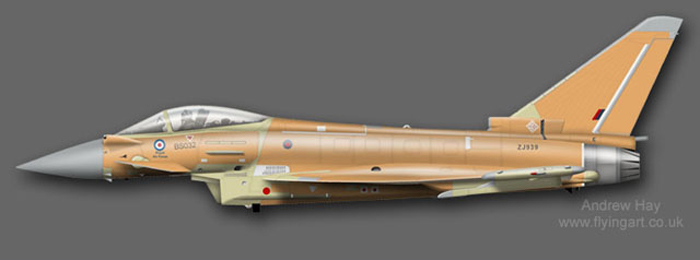
Weapons:
In 2002 the MBDA Meteor was selected as the long range air-to-air missile armament of Eurofighter Typhoon, however, due to delays in Meteor development the Typhoon will initally be equipped with the Raytheon AMRAAM as a stop gap measure. The current in-service date for Meteor is predicted to be August 2012.
The Typhoon has always been planned to be a swing role tactical fighter with robust air to ground capabilities. However the RAF's urgent air to ground requirement has resulted in the earlier than planned integration of an "austere" air to ground capability, based on the Rafael/Ultra Electronics Litening III laser designator and the Enhanced Paveway II LGB (see Cottesmore Aviation Group news 16th December 2006). A more comprehensive air to ground attack capability is planned for all partner nations but this is still a number of years away. The RAF's capability will now be available in the Block 5 aircraft delivered at the end of Tranche 1 and, by retrofit, on all RAF Tranche 1.
General characteristics:
Crew: Typhoon F.2=1 Typhoon T.1=2
Length: 15.96m (52ft 5in)
Wingspan: 10.95m (35ft 11in)
Height: 5.28m (17ft 4in)
Wing area: 50m2 (540ft2)
Empty weight: 11,000kg (24,250lb)
Loaded weight: 15,500kg (34,280lb)
Max take off weight: 23,500kg (51,809lb)
Powerplant: 2x Eurojet EJ200 afterburning turbofans, each producing 60kN dry; 90kN with afterburner (13,500lb/20,250lb thrust).
Performance: Maximum speed MACH 2.0+ at high altitude, MACH 1.2 at sea level. Supercruise MACH 1.3+ at altitude with typical air to air armament.
Range: 1,390km (864 miles)
Service ceiling: 18,000m (60,000ft)
Rate of climb: 255 m/s (50,000 ft/min)
Thrust to weight ratio: 1.18
Armament:
1x27mm BK-27 Mauser cannon
Air to Air: AIM-9 Sidewinder, AIM-132 ASRAAM, AIM-120 AMRAAM, MBDA Meteor, IRIS-T (Infra Red Improved Sidewinder with Thrust vector control)
Air to Surface: AGM-84 Harpoon, AGM-88 HARM, ALARM, Storm Shadow, Brimstone, Taurus, Penguin, Arminger, Paveway 2, Paveway 3, Enchanced Paveway, JDAM.
Example weapon loads:
- Interdiction/Strike: 27mm Mauser cannon, 2xStorm Shadow, 2xALARM, 4xAMRAAM, 2xASRAAM, 2x1,500 litre wing drop tanks, 1x1,000 litre centre line drop tank.
- Close Air Support (CAS): 27mm Mauser cannon, 18xBrimstone, 4xAMRAAM, 2xASRAAM, 1x1,000 litre centre line drop tank.
- Suppression & Destruction of Enemy Air Defences: 27mm Mauser cannon, 6xALARM, 4xAMRAAM, 2xASRAAM, 1x1,000 litre centre line drop tank.
- Maritime Attack: 27mm Mauser cannon, 4xPenguin, 4xAMRAAM, 2xASRAAM, 2x1,500 litre wing drop tanks, 1x1,000 litre centre line drop tank.
- Air Superiority: 27mm Mauser cannon, 6x AMRAAM, 2xASRAAM, 2x2,000 litre wing drop tanks, 1x1,000 litre centre line drop tank or 3x1,000 litre drop tanks.

© On Target Aviation 2008
